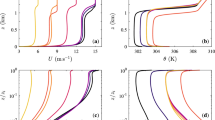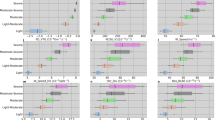Summary
The primitive equations of motion are solved to find peak latitudes of families of trajectories of air moving from low latitudes towards the pole from a state of rest under the action of a constant meridional pressure gradient. The general case is discussed first and then calculations are applied to the 20° West meridian in January and July for the Northern Hemisphere.
The resulting mass transposition indicates that a belt of convergence should occur at about 32° N in January; this agrees well with the latitude of the axis of the mean sub-tropical high pressure belt at that time of year.
The nature of the climatological model in low latitudes suggested by the calculation is then discussed.
Zusammenfassung
Die vereinfachten Bewegungsgleichungen werden gelöst, um Scheitelbreiten für Trajektorienscharen der Luftbewegungen zu finden, die ausgehend von dem Ruhezustand unter Einwirkung eines konstanten meridionalen Druckgradienten polwärts gerichtet sind. Der allgemeine Fall wird diskutiert und es werden Berechnungen für den 20. westlichen Längengrad der Nordhemisphäre für Januar und Juli durchgeführt.
Der resultierende Massentransport zeigt, daß im Januar in 32° N ein Konvergenzgürtel auftreten sollte. Dies stimmt gut überein mit der geographischen Breite der Achse des mittleren subtropischen Hochdruckgürtels zu dieser Jahreszeit.
Schließlich wird die Form des klimatologischen Modells für niedere Breiten, das durch diese Berechnungen nahegelegt wird, diskutiert.
Résumé
Résolution des équations simpflifiées du mouvement pour déterminer l'origine des faisceaux de trajectoires des courants aériens qui, partant du repos, sont dirigés vers le pôle sous l'effet d'un gradient constant de pression méridien. Discussion du cas général; calcul pour le 20e méridien Ouest de l'hémisphère Nord en janvier et en juillet.
Le transport de masse résultant montre qu'il doit y avoir en janvier, a 32° de latitude Nord, une ceinture de convergence ce qui concorde bien avec la latitude de l'axe de la zone moyenne des hautes pressions subtropicales en cette saison.
Forme du modèle climatologique aux basses latitudes suggéré par ces calculs.
Similar content being viewed by others
References
Gordon, A. H., andP. M. Shaw: Application of Particle Dynamics to Derive a General Circulation in Low Latitudes. Arch. Met. Geoph. Biokl. A,6, 319–333 (1954).
Riehl, H.: Tropical Meteorology. London: McGraw-Hill. 1954.
Gordon, A. H.: The Seasonal Fluctuations in the Belts of Maximum Convergence and Divergence in the North Atlantic Ocean. Quart. J. Roy. Met. Soc.77, 302 (1951).
Author information
Authors and Affiliations
Additional information
With 1 Figure
Rights and permissions
About this article
Cite this article
Gordon, A.H. A low latitude general circulation model. Arch. Met. Geoph. Biokl. A. 10, 339–349 (1958). https://doi.org/10.1007/BF02247148
Published:
Issue Date:
DOI: https://doi.org/10.1007/BF02247148




